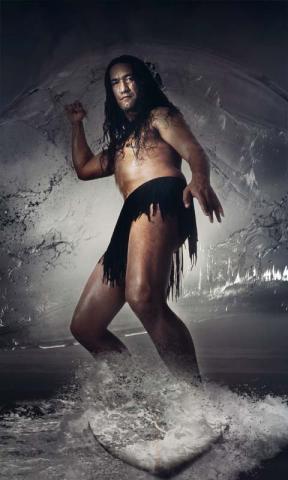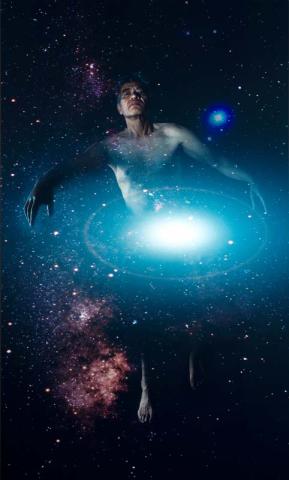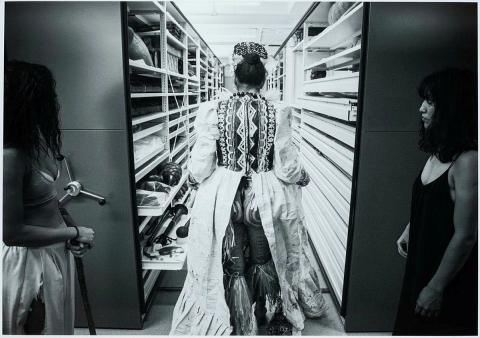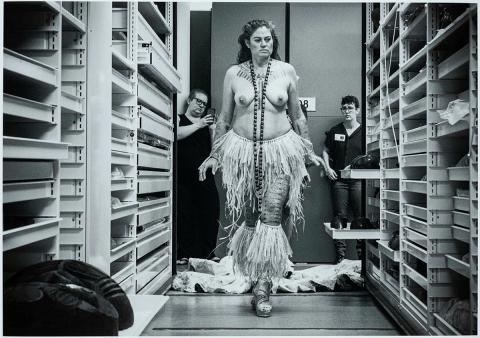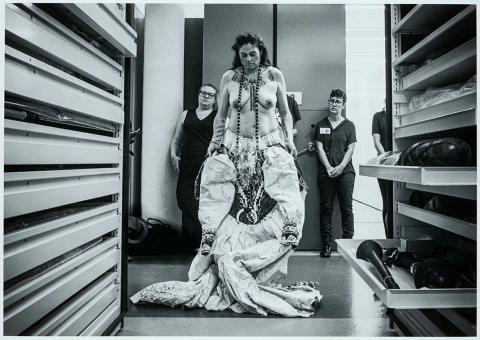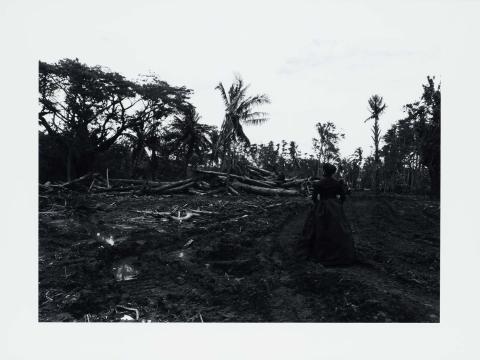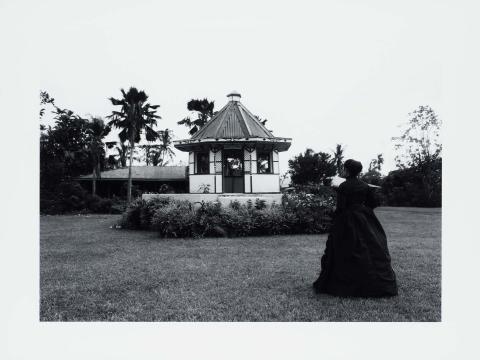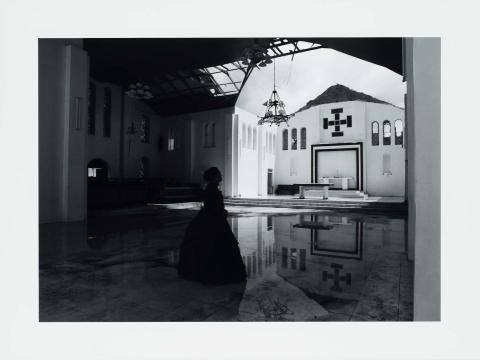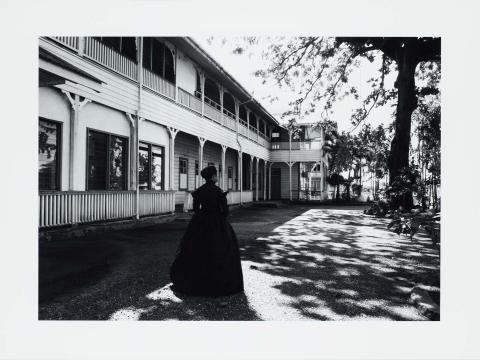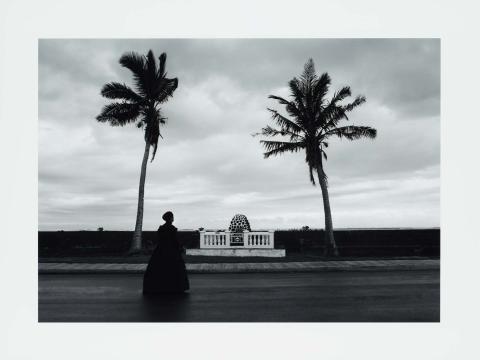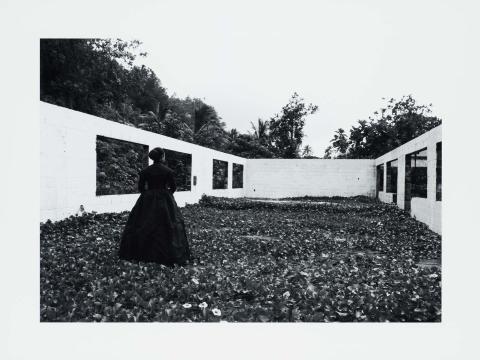Hey Sis: 'sis: Pacific Art 1980–2023'
By Ruth McDougall
Artlines | 3-2023 | September 2023
Editor: Stephanie Kennard
Since the Asia Pacific Triennial of Contemporary Art (APT) began in 1993, the series has been celebrated for its engagement with Aotearoa New Zealand and the wider Pacific. Through the APT, the Gallery has built a collection of vibrant works by Pacific women artists. A significant number of these have been acquired through generous bequests made by two women: Jennifer Phipps (1944–2014) and Jennifer Taylor (1935–2015). Staged in two rotations in the upper galleries of GOMA, ‘sis: Pacific Art 1980–2023’ is the latest in a series of exhibitions1 to profile and celebrate the depth of this important area of the Collection, writes curator Ruth McDougall.
In 2016, retired National Gallery of Victoria curator Jennifer Phipps made a significant bequest to QAGOMA to establish the Oceania Women's Fund and support the ongoing development of women artists’ practices in the Pacific.2 Phipps was moved to this action through her close friendship with her colleague, Bougainville-born curator Sana Balai, and her own involvement with artists and women from this much overlooked region. As Balai has more recently shared, ‘we don’t see much contemporary art from outside of the Polynesian centres in Aotearoa New Zealand in our Galleries here, let alone the work of women from the “islands”’.3 Together with a bequest received in the same year from Australian architect, professor, critic and author Jennifer Taylor, the Oceania Women's Fund has consolidated an already strong commitment within QAGOMA to acquiring and profiling the diversity of Pacific women’s practices across the region.
Featuring 162 works by 30 artists, the first rotation of ‘sis: Pacific Art 1980–2023’ reflects on practices of women from Hawai’i, the Autonomous Region of Bougainville, Tonga, Vanuatu, the Republic of the Marshall Islands, Papua New Guinea, Fiji, and their diasporas. Bringing together works by internationally celebrated figures Latai Taumoepeau, Taloi Havini, Kapulani Landgraf and Kathy Jetñil-Kijiner alongside artists from the island communities ‘back home’, this display introduces audiences to the deep sense of attachment and responsibility that each woman has to their land, community and culture.
Although seeming quiet in their presentation, the revival of knowledge associated with the patterns in woven pandanus Jaki-ed mats, created by Marshallese artists such as Susan Jieta, makes them as deliberate and as powerful as the compelling performance poetry of their ‘sister’, Kathy Jetñil-Kijiner, in their response to the loss of sovereignty over land and culture resulting from histories of conflict, colonialism, nuclear testing and climate change. Like Jetñil-Kijiner, Jieta and her fellow Jaki-ed weavers spend hours deeply focused — in a time of peril — on the creation of symbols of cultural resilience.
Such perils for Pacific peoples, specifically those facing the immediate and dramatic effects of climate change, are also addressed by Tongan Punake4 Latai Taumoepeau, who uses her own body in a series of durational performances. Documented through video, Taumoepeau’s works viscerally evoke the interdependence of Pacific peoples and their environment. In Repatriate 2015, for example, we witness the artist in a glass tank desperately trying to perform a tau’olunga (Tongan dance) as the enclosure slowly fills up with water. As we watch the artist’s desperate efforts to maintain her movements against the force of the water, the labour required of Pacific peoples in the face of rising sea levels and catastrophic weather events is brought home.
Employing an array of approaches across photography, video installation, ceramics and sound, the work of Bougainville-born Taloi Havini speaks to the importance, more particularly, of women’s labour as well as their matrilineal connections to land. The elegant sculptural form of Beroana (shell money) II 2016 is inspired by the long strands of shells (known as beroana) created by women for use in ceremonial exchanges, including weddings, reconciliations and funerals. Comprising over a thousand hand-formed stoneware porcelain and earthenware ‘shells’, hung to replicate the shape of the open-pit Panguna mine in Central Bougainville, Beroana (shell money) II contrasts the once-robust economy of Havini’s people — grounded in labour and respectful interactions with their environment — with the destruction, displacement and conflict of global extractivism.5
Similarly concerned with the impacts of development and extraction, Kanaka ‘Öiwi artist Bernice Akamine documents endangered native plants in her homeland of Hawai’i, using knowledge handed down from her grandmother to create natural dyes resulting in subtly coloured fabrics, then intricately embroidering portraits of each plant on them.6 In doing so, Akamine references how Hawaiian women have maintained important Indigenous cultural practices, values and knowledge by innovatively adopting and transforming the techniques and artforms introduced by the wives of Western missionaries.
In the second chapter of the exhibition, opening in late March 2024, ‘sis’ continues sharing artworks and practices that negotiate the impact of Western values, ideas and encounters on the peoples and cultures of the Pacific. Drawing together works from Aotearoa New Zealand, Papua New Guinea, Fiji, Australia, the Cook Islands and Tahiti, this display explores the many ways in which Pacific women continue to respond to the changes these histories have brought.
The work of Māori artist Lisa Reihana uses lens-based media to rethink moments of encounter, privileging the histories and perceptions of Pacific peoples. One of the legacies of the European voyages of discovery and subsequent colonisation of Aotearoa has been the diminishment of traditional leadership roles for women and the demonisation of female ancestor figures ostensibly driven by Christian values and ideas. In her 2001– series ‘Digital Marae’, Reihana reasserts the significance of goddesses such as Hinepūkohurangi and Mahuika, using new technologies to position them alongside their male counterparts as foundational supports within the sacred Māori architectural space of the marae.
Responding to the lack of respect expressed towards contemporary Melanesian women, Mekeo artist Julia Mage’au Gray’s work focuses on the importance of cultural tattoos or marks, created and worn by women as a symbol of strength and body sovereignty. The difficult, collective journey of re-awakening cultural practices once banned by Christian missionaries is honoured in the installation From old to new old 2023 created by Gray along with a core group of four Papua New Guinean women who have travelled with her.7 Inspired by the undiminishable spirit of Pacific heroines such as Purea, Tevahine-'ai-roro-atuai- Ahurai, the self-proclaimed ‘Queen of Tahiti’, Aotearoa New Zealand-born Rosanna Raymond creates avatars whom she then introduces into the very colonial infrastructure of Western museums and exhibition events.8 Raymond’s Backhand Maiden 2015– enters these museum contexts to explore ideas of ‘conser.VA.tion’, comprising an Edwardian-style dress made from Fijian masi (barkcloth). Throwing away the white gloves, Raymond asserts the genealogical links between her ‘Pacific’ body and these objects, donning Backhand Maiden and stressing the ways in which this avatar’s interactions brings back warmth and life force to the cold and forgotten taonga (treasures).
The elegance of Cook Islander women dancing with fans is evoked in the dazzling cutout patterning of Tungane Broadbent’s tivaevae in Tairiiri (fan) 2005–06. As with the traditional creation of Cook Islander barkcloth and woven mats, the quilted tivaevae are also constructed from multiple layers. Created to be used, gifted and exchanged within in ceremonies accompanying rites of passage, tivaevae are one of the most important forms of aesthetic and cultural expression for Cook Islander women. Highly valued, tivaevae are yet another instance of Pacific women self-consciously using new technologies — in this case, sewing — in the maintenance and expression of their vibrant culture.
Works in ‘sis’ contribute towards the development of more nuanced understandings of Pacific cultures and traditions, and of how histories of colonisation have played out in unique ways for individuals and communities across the region. Another objective of the exhibition is to broaden perceptions of gender, including teasing them out through engagement with artists with ancient gender roles, such as Lehuauakea, a māhū from Hawai’i, and Yuki Kihara, a fa’afafine from Samoa. Many Pacific Island countries have designations that acknowledge non-binary gender identifications: Māhu (Hawai’i), Vakasalewalewa (Fiji), Palopa (Papua New Guinea), Fa’afafine (American Samoa and Samoa), Akava’ine (Cook Islands), Fakafifine (Niue), Fakaleiti/Leiti (Tonga). Rather than seek an elevated status for women, the exhibition seeks to champion agency, respect and empowerment for all genders.
We hope that visitors to ‘sis’ are inspired by the amazingly diverse and vibrant ways in which Pacific women seek to engage in histories and issues that we all, in some way, share. With warmth and generosity, the exhibition offers a deeper understanding of the work that our Pacific sisters have taken on, redressing past wrongs while creatively engaging in new conversations about the world and our place in it. Like its title, the works in ‘sis’ are generous, inclusive and relational, and through them, the artists point to our shared responsibility for creating a future of responsible stewardship.
Ruth McDougall is Curator, Pacific Art, QAGOMA. She led the ‘sis’ curatorial team of Ruha Fifita, Curatorial Assistant, Pacific Art, QAGOMA, and curatorial volunteers Moale James and Emily Nguyễn-Hunt. ‘sis’ is on display at GOMA, until 8 September 2024.
Endnotes
- Curated by Maud Page, ‘Islands Beats’ opened at QAG in 2003 and featured textiles by Pacific women in Australia and Aotearoa. Celebrating the significance of textile practices on the islands of Fiji, Samoa, Tonga, Cook Islands, Tahiti and Hawai’i, and built on ‘Island Beats’, the ‘Pacific Textiles Project’ was a highlight of APT5 (2006). Staged in the upstairs galleries of GOMA, ‘Threads: Contemporary Textiles and the Social Fabric’ (2011) brought the vibrant textiles of Pacific women into conversation with equally significant practices from Asia and Australia.
- See https://www.artlink.com.au/articles/4266/jenniferphipps-1944E280932014/, accessed May 2023.
- Sana Balai, ‘Women’s Wealth’, APT9 Interlocutors presentation, GOMA, Brisbane, November 2017.
- Punake is a term used in Tonga to describe a body-centred performance artist.
- The Panguna mine in Central Bougainville was the catalyst for a decade-long civil war in Bougainville and caused immense environmental damage to the surrounding river systems and land, with the rivers being used for the disposal of toxic mine-tailings. While the mine delivered immense wealth to the PNG government and foreign investors in the parent company Rio Tinto, landowners received little remuneration.
- Akamine is considered a kumu (teacher) of waiho’olu’u (Indigenous plant-dyeing)
- Commissioned for ‘sis’, From old to new old 2023 involves Ranu James, Moale James, Katrina Sonter and Vasa Gray.
- Purea was the high chieftainess of the Landward Teva Tribe of Tahiti and became famous during the first European expeditions to Tahiti. The lover of Tahitian navigator Tupia, Purea was the self-proclaimed ruler of all Tahiti.
Feature image: An installation view of ‘sis’, with glimpses of work by (l–r) Yuki Kihara, Rosanna Raymond and Emma Tamarii, GOMA, April 2024 / © The artists / Photograph: J Ruckli, QAGOMA
Connected objects

(Jaki-ed) 2017
- JIETA, Susan - Creator

Repatriate 2015
- TAUMOEPEAU, Latai - Artist
- NOHRA, Elias - Co-author and cinematographer
- STEGH, Bec - Editor and Visual Effects
- BROWN, James - Sound design
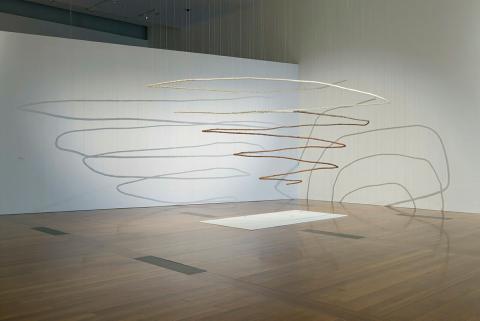
Beroana (shell money) II 2016
- HAVINI, Taloi - Creator

Tairiiri (fan) 2005-06
- BROADBENT, Tungane - Creator
